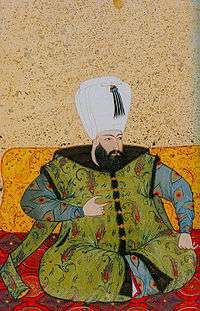Mahfiruz Hatice Sultan
| Mahfiruz Hatice Sultan | |
|---|---|
| Born |
Eudoxia Rumelia |
| Died |
Before 1620 Edirne, the Ottoman Empire |
| Burial | Eyüp Cemetery, Istanbul |
| Spouse | Ahmed I |
| Issue | Osman II |
| Religion | Islam, previously Orthodoxy |
Mahfiruz Hatice Sultan[a] (c. 1590 – by 1610 or 1620) was a wife of Ottoman Sultan Ahmed I (r. 1603–17) and mother of Sultan Osman II (r. 1618–22).
Life
According to historian Baki Tezcan, nothing is known about her except her probable name and period of death.[1][b] Her Muslim name, Mahfiruz, means "favourite of the crescent". Such peculiar names were given to the women of the Imperial Harem.[2]
She was the first of Ahmed I's three women and bore him Osman II. With the birth of Osman, the couple's first child, Ahmed became the youngest Ottoman sultan to become father, and Osman was the first Ottoman first-born prince to be born in the Imperial capital of Istanbul.[3]
Assessment by Peirce
The date of her death is undetermined. There are evidence that strongly suggests that she died at latest by 1610.[1] According to Leslie P. Peirce, she was alive when Osman was enthroned as sultan in 1618 after the deposition of incompetent Mustafa I; Peirce believes that she was not living in the palace during his son's reign nor did she act as valide sultan, as privy purse registers listed no valide sultan during Osman's reign.[4] Also from the middle of 1620, Osman's governess, the daye hatun, began to receive an extraordinary large stipend, one thousand aspers a day rather than her usual two hundrend aspers, an indication that she was now the official stand-in for the Valide Sultan.[4] Mahfiruz may have fell out of favour, judging by her absence in the palace and burial in Eyüb rather than with her husband, and never have recovered her status as a royal consort.[4] Venetian ambassador Contarini reported the beating of a woman who had irritated Kösem, ordered by the sultan, in 1612, which may be identified to Mahfiruz.[4] She may have been a rival of Kösem, who made efforts to keep Mustafa safe from execution, and saw an obstacle in Mahfiruz.[4] She was buried in the large sanctuary of Eyüp, Istanbul.[4]
In popular culture
In the 2015 TV series Muhteşem Yüzyıl: Kösem, Mahfiruz Hatice Sultan is portrayed by Turkish actress Dilara Aksüyek.
See also
Annotations
References
- 1 2 3 Tezcan 2007, p. 350.
- ↑ Paulus Cassel (1888). An Explanatory Commentary on Esther: With Four Appendices Consisting of the Second Targum Translated from the Aramaic with Notes : Mithra : the Winged Bulls of Persepolis : and Zoroaster. T. & T. Clark. p. 56.
favourite of the crescent
- ↑ Baki Tezcan (13 September 2010). The Second Ottoman Empire: Political and Social Transformation in the Early Modern World. Cambridge University Press. pp. 115–. ISBN 978-0-521-51949-6.
- 1 2 3 4 5 6 Peirce 1993, p. 233.
- ↑ Osmanlılar ansiklopedisi. Yapı Kredi Kültür Sanat Yayıncılık. 1999. p. 53. ISBN 978-975-08-0071-9.
Hatice Mahfıruze, Mahfiruz, Mah-ı Feyruz
- 1 2 Günseli İnal; Semiramis Arşivi (2005). Semiramis: Sultan'ın gözünden şenlik. YKY. p. 27. ISBN 978-975-08-0928-6.
[Osman II's mother the Serbian Evdoksiya known as Mahfiruz Sultan]
- ↑ Murat Iyigun (7 May 2015). War, Peace, and Prosperity in the Name of God: The Ottoman Role in Europe's Socioeconomic Evolution. University of Chicago Press. p. 119. ISBN 978-0-226-23228-7.
Mahfiruz H. S. Serbian
- ↑ Ali Kemal Meram (1977). Padişah anaları: resimli belgesel tarih romanı. Öz Yayınları. p. 279.
Kendisi gibi bir Rum olan ve (Mahfiruz Sultan) takma adı ile tanınan (Evdoksia) nın oğlu Osman'ın
- ↑ İsmail Metin (2010). Osmanlı sarayında cinsel sapkınlıklar. Parşömen Yayınları. p. 179. ISBN 978-605-4452-20-0.
Birinci Ahmet'in gözdelerinden ilki Evdoksia idi. Kendisi Rum idi. Sarayda ismi Mahfiruz Sultan oldu.
- ↑ Tezcan, Baki (2002). "The 1622 Military Rebellion in Istanbul : A Historiographical Journey". International Journal of Turkish Studies. University of Wisconsin: 40.
Stanford Shaw, the author of an Ottoman history that has been widely used as a textbook and reference work, claims, on the basis of information from an eighteenth-century French novel,84 that the sultan was "[t]rained in Latin, Greek, and Italian by his Greek mother, as well as Ottoman Turkish, Arabic, and Persian."85
Sources
- Peirce, Leslie P. (1993). The Imperial Harem: Women and Sovereignty in the Ottoman Empire. Oxford University Press. pp. 233–. ISBN 978-0-19-508677-5.
- Tezcan, Baki (2007). "The Debut of Kösem Sultan's Political Career". Turcica. Éditions Klincksieck. 39–40: 350.
- Nazım Tektaş (2004). Harem'den taşanlar. Çatı. pp. 183–185. ISBN 978-975-8845-02-6.

